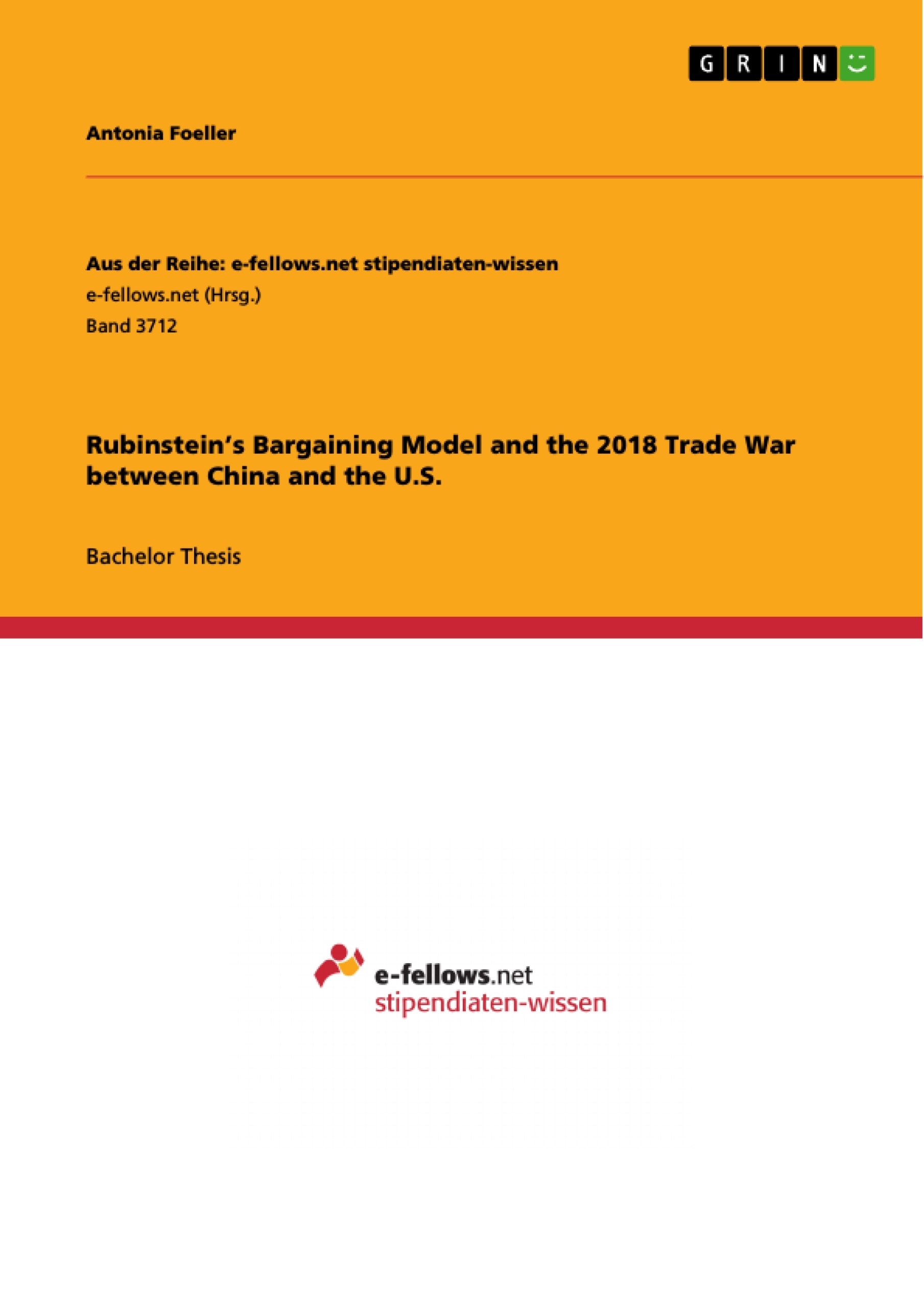This thesis applies a game theoretical approach to analysing the potential outcomes of the current trade war between the U.S. and China. The impact of tariffs on the American steel industry, as well as the Chinese soy bean industry will be predominantly examined. This is done by introducing a new expansion on Rubinstein’s Bargaining Model of 1982 in order to replicate the interaction between the U.S. and China. First, within Chapter 2, the thesis explains how a trade war is characterized, as well as the historic and current relationship between the U.S. and China. In this context, the starting point for later calculations is set. In Chapter 3, the original Rubinstein Bargaining Model and its underlying classic game is described and explained. In this thesis, two sub-models are considered: The Fixed Cost Model and the Fixed Discounting Factor Model. These are firstly defined within the original framework and secondly developed further to fit the Sino-American trade war context. The underlying assumptions and intuitions of the expansion are explained.
Further, the main equations for the numeric examples are derived. Chapter 4 contains the main focus of this thesis; examining the existence and characteristics of equilibria within the Rubinstein Bargaining Model and its trade war expansion. The equilibria are analysed using numeric examples. On this basis, the impact of different variables, e.g. the market share elasticity with respect to tariffs, will be assessed. These results will then be interpreted and compared to Rubinstein’s original solution. Lastly, in Chapter 5, the model and its results in the trade war context will be assessed with respect to its advantages and limits. The conclusion follows with an outlook on some possibilities to further expand on the model.
Inhaltsverzeichnis (Table of Contents)
- Introduction
- Trade war between China and the U.S.
- Trade war
- History of the Sino-American relationship
- The current situation
- The Rubinstein Bargaining Model
- The basic idea of the Rubinstein Bargaining Model
- The Rubinstein Bargaining Model in the Sino-American trade war context
- The perfect equilibria of the Sino-American trade war expansion of the Rubinstein Bargaining Model
- Theoretical solution of the Rubinstein Bargaining Model
- Rubinstein's equilibrium of the Fixed Cost Model
- Rubinstein's equilibrium of the Fixed Discounting Factor Model
- Assumptions for the numerical example
- Current market sizes
- Fixed proposal Costs
- Fixed discounting factor
- Market share elasticities
- Different ways of tariff adaption
- Outcomes of the different scenarios
- Results of the numeric Fixed Cost Model scenario
- Results of the numerical Fixed Discounting Factor Model example
- Interpretation of results
- Assessment of the model
- Limits to the model to explore the Sino-American relationship
- Advantages of the model to explore the Sino-American relationship
- Conclusion and outlook
Zielsetzung und Themenschwerpunkte (Objectives and Key Themes)
This bachelor thesis examines the 2018 trade war between China and the U.S. through the lens of Rubinstein's Bargaining Model. The objective is to analyze the dynamics of the trade war using this theoretical framework and explore its implications for the Sino-American relationship. The thesis aims to provide insights into the negotiation process, potential outcomes, and the limitations of this model in analyzing complex real-world scenarios.
- The history and evolution of the Sino-American trade relationship
- The application of Rubinstein's Bargaining Model to the trade war scenario
- The impact of tariffs and other trade barriers on market dynamics
- The negotiation strategies and outcomes under different model assumptions
- An assessment of the model's strengths and limitations in analyzing complex geopolitical situations
Zusammenfassung der Kapitel (Chapter Summaries)
- The introduction provides an overview of the thesis, outlining its objectives, key themes, and research approach.
- Chapter 2 discusses the historical context of the trade war between China and the U.S., analyzing the factors leading to the current situation and outlining the key issues at stake.
- Chapter 3 introduces Rubinstein's Bargaining Model, explaining its underlying principles and how it can be applied to the analysis of the Sino-American trade war.
- Chapter 4 explores the application of the Rubinstein Bargaining Model to the trade war scenario, presenting theoretical solutions and analyzing numerical examples under different assumptions.
- Chapter 5 assesses the strengths and limitations of the Rubinstein Bargaining Model in exploring the Sino-American relationship, highlighting its potential and its shortcomings in capturing real-world complexities.
Schlüsselwörter (Keywords)
The main keywords and focus topics of the thesis include: Rubinstein Bargaining Model, trade war, Sino-American relationship, tariffs, market share elasticities, negotiation strategies, game theory, political economy, international trade, and economic modeling.
- Quote paper
- Antonia Foeller (Author), 2018, Rubinstein’s Bargaining Model and the 2018 Trade War between China and the U.S., Munich, GRIN Verlag, https://www.grin.com/document/974358




